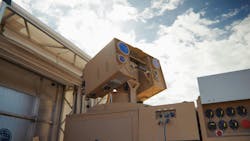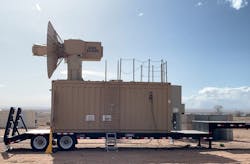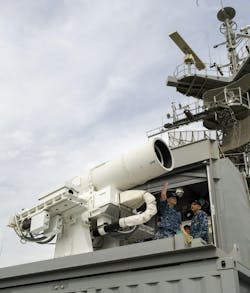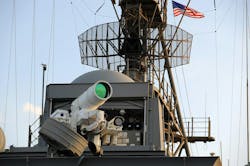Laser, microwave, and other directed-energy weapons ready for the battlefield
Perhaps no technology has shaped the 21st-century battlefield as profoundly as the drone. These uncrewed aerial vehicles (UAVs), along with their land and sea counterparts, have redefined the way wars are fought by providing military forces with unprecedented capabilities in surveillance, precision targeting, and intelligence gathering -- all while reducing the risk to their own personnel. Drones have made complex operations more efficient and less costly, enabling militaries to strike with pinpoint accuracy and maintain a persistent presence over the battlefield.
As the century progresses, the influence of drones continues to expand beyond traditional state actors. Non-state groups and non-peer adversaries increasingly have adopted this technology, leveraging it to level the playing field in conflicts around the world. With commercial drones becoming more accessible, these actors can conduct reconnaissance, drop bombs, and challenge conventional military forces in ways that previously were unimaginable.
The influence of drones flows across all domains of warfare. Loitering munitions, or "Kamikaze drones," have disrupted traditional force structures by providing smaller, more agile units with the ability to strike high-value targets such as tanks, artillery, and command centers.
Meanwhile, underwater drones and ground robots are expanding the reach of unmanned warfare to new environments, further cementing their role in the future of conflict.
Now, the U.S. Department of Defense (DOD) and allies are looking once again to gain the upper hand with a relatively low-cost alternative counter-UAS of their own in the form of laser and other directed-energy weapons.
Conflicts that involve drones in areas such as the Red Sea, the Gulf of Aden, and Bab al-Mandeb Strait, are wreaking havoc on U.S. military forces and commercial shipping.
Likewise, Iran and the Lebanese Islamist political and paramilitary group Hezbollah have used drones to attack Israel as part of their support for Hamas in the besieged Gaza Strip following the deadly Hamas attacks on 7 October 2023. The Houthis likewise justified their attacks as a show of solidarity with Palestinians.
In late 2023, the DOD reported that U.S. Navy destroyers shot down nearly 40 drones and several missiles in the Red Sea. While the Navy has succeeded in stopping uncrewed air and sea vehicles, they come at a steep financial cost.
It is estimated that Iranian-made drones cost approximately $2,000 each. While the DOD - citing operational security - has not disclosed what it is using to destroy the Houthi weapons, it is believed to employing the Standard Missile-2, which costs approximately $2.1 million per shot.
"That quickly becomes a problem because the most benefit, even if we do shoot down their incoming missiles and drones, is in their favor,", says Mick Mulroy, a former DOD official and Central Intelligence Agency (CIA) officer. "We, the U.S., need to start looking at systems that can defeat these that are more in line with the costs they are expending to attack us."
Speed of light
Lasers -- an acronym for light amplification by stimulated emission of radiation -- have been penciled in by fiction writers as the future weapons in use across galaxies in sci-fi stories. While lasers have been in use in civilian and military applications since the technology was developed in 1960, the deployable "ray gun" remained out of reach until about a decade ago. In 2014, the U.S. Navy outfitted its Austin-class amphibious transport dock USS Ponce with the AN/SEQ-3 Laser Weapon System (LaWS), which was made by Kratos Defense & Security Solutions, Inc. in San Diego.
The AN/SEQ-3 is a 30-kilowatt solid-state ship-mounted laser developed to neutralize a range of low-level threats like small boats and drones. LaWS converts electrical energy from the ship into a focused beam of light that can be aimed at critical components of a target, such as engines or sensors, to incapacitate or destroy it. LaWS causes structural damage or detonates explosive materials onboard the target by delivering an overwhelming amount of heat. Unlike traditional kinetic weapons that rely on impact and shrapnel, LaWS employs directed energy to burn through parts of the target.
LaWS offers versatility by allowing operators to adjust its power levels. It can operate at lower intensities to dazzle or disable sensors, or at higher intensities to destroy threats. The system tracks targets through optical systems and can engage them over several kilometers with precision, providing a reliable solution for defending against several low-cost threats.
Integrated with the ship's radar and fire control systems, LaWS operates at the speed of light, enabling rapid response to emerging threats. Its precision targeting minimizes collateral damage, making it well-suited for complex and populated environments.
LaWS was developed as a prototype to test the feasibility of laser weapons in the ocean environment, and the Navy moved forward with the development and deployment of a higher-powered system produced by Lockheed Martin's Laser and Sensor Systems division in Bothell, Wash.
Dubbed the High Energy Laser with Integrated Optical Dazzler and Surveillance (HELIOS) system, it has at least double the power of its predecessor. The company said HELIOS was rated at more than 60 kilowatts. Although the specifics of HELIOS remain classified, it may see potential increases to 100 or 150 kilowatts for future deployments. The system will also feature a lower-power optical dazzler for disrupting intelligence and reconnaissance sensors. The system was installed on the USS Preble, an Arleigh Burke-class destroyer, after delivery in 2022.
U.S. Secretary of the Navy, Carlos Del Toro, told Congress at a hearing earlier this year that "We've accelerated the development and the testing of the HELIOS laser program ... We also have six other laser projects and high energy projects, some of which are classified. And I can't talk about openly. But this is a high priority area for us. We obviously well into the future, cannot continue to shoot down drones which simply SM2 and SM6, we need to develop the high energy, high lasers and directed-energy programs to be able to counter these air drones that are being shot at us as well."
"Lockheed Martin and the U.S. Navy share a common vision and enthusiasm for developing and providing disruptive laser weapon systems," says Rick Cordaro, vice president of Lockheed Martin Advanced Product Solutions. "HELIOS enhances the overall combat system effectiveness of the ship to deter future threats and provide additional protection for sailors, and we understand we must provide scalable solutions customized to the Navy’s priorities. HELIOS represents a solid foundation for incremental delivery of robust and powerful laser weapon system capabilities."
Earlier this year, Navy Secretary Del Toro told attendees at the McAleese Defense Programs Conference in Washington that directed-energy weapons are key to his top goal of strengthening maritime dominance.
"It is an exciting time for new technologies in our Navy and Marine Corps," Del Toro told attendees. "Our amphibious ships play a crucial role in testing and validating our newest directed-energy weapons technology, including the Laser Weapon System Demonstrator (LWSD). USS Portland (LPD 27) was fitted with LWSD and engaged a marine target in the Gulf of Aden.
He continued, "And while I was in San Diego last month, I visited USS Preble (DDG 88), fitted with the HELIOS laser weapon system. Directed energy weapons, including high-energy lasers, are the future of warfare -- offering a lower cost-per-shot against air and missile defense engagements."
In the field
The U.S. Army have also deployed a directed-energy system of its own aimed at keeping soldiers safe from UAVs and rockets, artillery, and mortars.
In 2021, the Army tested 50-kilowatt laser weapons mounted on Stryker combat vehicles, conducting additional evaluations. The Army tested the Maneuver-Short Range Air Defense (M-SHORAD) system, developed by Raytheon, which features a vehicle-mounted laser powered by a gasoline generator.
In collaboration with Kord Technologies, a subsidiary of KBR located in Huntsville, Ala., the Army integrated the high-energy laser onto an eight-wheeled Stryker vehicle produced by General Dynamics Land Systems in Sterling Heights, Mich. During the 2021 trials at White Sands Missile Range in New Mexico, the laser system tracked, targeted, and neutralized 60-millimeter mortar rounds and drones of varying sizes. This achievement is part of an ongoing effort to equip more powerful lasers on smaller, more mobile platforms.
The M-SHORAD system also demonstrated how laser weapons can integrate into broader command and control networks. While it includes its own radar system, it also can connect to the air surveillance data provided by the Terminal High Altitude Area Defense Command and Control system (THAAD C2), enhancing situational awareness and coordinated defense efforts.
"There’s no doubt lasers will be on the future large-scale ground combat battlefield so it’s great to see these initial prototypes to gain understanding of its capabilities and think through where these capabilities will fit into our organizations, the impact on how we fight, and understand how we need to adjust our doctrine," says Army Maj. General Ken Kamper, commanding general of the Fires Center of Excellence in 2022. "The laser, as part of a necessary layered set of capabilities against threat unmanned aircraft systems, has tremendous potential."
High Energy Laser (P-HEL) system on wheels
This spring, BlueHalo in Arlington, Va., won a four-year support contract for the Army's Palletized High Energy Laser (P-HEL) system. The system, which is based on BlueHalo's LOCUST LaWS, is in use to counter small UAVs. LOCUST is a short-range air defense system designed for quick deployment and mobility.
The self-contained laser is built to handle all aspects of beam control, power management, thermal regulation, and safety. The system transports on standard equipment such as forklifts or pickup trucks and runs on an internal power-management system. The LOCUST LWS features modular components that operators can service or replace in the field. It operates through a single-operator interface using familiar Xbox-style controls. Setup features an integrated checklist that brings the system to full operational status within 15 minutes of powering up.
The mobility of HEL systems adds a significant tactical advantage, enabling these systems to accompany ground forces and provide a protective shield in dynamic combat environments. Mounted on wheeled or tracked vehicles, these systems can move with troops and deliver air defense against threats that would otherwise overwhelm static defenses. By enabling real-time engagement of several threats, P-HEL systems enhance force protection and operational flexibility.
The laser offers scalable output, ranging from two to 20 kilowatts, enabling it to engage a wide range of airborne threats, including drones and projectiles. The system's radar, a pulse-Doppler array, provides full hemispheric coverage and is capable of supporting counter-unmanned aerial systems, air defense, and detection of incoming hostile fire. Even in the event of a laser amplifier failure, the system continues to operate with reduced power.
Target tracking is handled by a specialized camera with zoom optics and a laser rangefinder, allowing for precise engagement of moving threats. The system's sensors provide high-definition imaging for day and night use, and its thermal and power management systems allow for extended operation in various environments. Powered by batteries, generators, or external power sources, BlueHalo says LOCUST is capable of continuous laser firing for extended periods and can operate for up to 24 hours in tracking mode.
"With this contract, BlueHalo is now providing full-scale Directed Energy support to our customers–at home through advanced innovation, in the field through maintenance and training support, and strategically through operational guidance and battlespace management," says Jonathan Moneymaker, BlueHalo Chief Executive Officer.
This spring, Doug Bush, the Army's head of acquisitions, told Forbes that the Army had used laser weapons in the Middle East to take down hostile drones. Bush, who was nominated and confirmed as the Assistant Secretary of the Army for Acquisition, Logistics and Technology, declined to inform Forbes what laser system earned the kills, though the P-HEL as been in use overseas since November 2022.
Microwave mindset
Beyond lasers, directed-energy technologies also include microwave weapons. These function by emitting concentrated bursts of electromagnetic energy at microwave frequencies.
Microwave systems utilize non-ionizing radiation, which doesn’t ionize atoms but is effective in disrupting electronic circuits and components. This may prove especially effective at combating swarms of drones.
One microwave weapon garnering attention is the Tactical High-Power Operational Responder (THOR), which is being developed by the U.S. Air Force Research Lab to combat the rising threat of swarming drones. When a swarm of drones is detected, THOR emits a wide-area burst of microwave energy that disables several drones simultaneously, making it highly effective against coordinated, large-scale drone attacks that are designed to overwhelm conventional defenses.
THOR's primary strength lies in its ability to engage several targets at once. While laser systems require precise aiming and can engage one target at a time, THOR’s microwave pulses affect all drones within its range, neutralizing swarms efficiently. By disabling drones' electronic systems, THOR avoids the need for physical projectiles, reducing collateral damage and eliminating the need for kinetic engagement.
The system is highly deployable and simple to operate, designed to be mounted on various platforms, including vehicles or ground-based installations. THOR’s microwave emitter is rapidly directed at incoming threats, making it highly responsive in dynamic combat scenarios. With an effectively unlimited magazine, constrained only by its power supply, THOR offers a continuous defense solution without the need for ammunition resupply.
Microwave weapons rely on devices like magnetrons, klystrons, or other microwave generators to convert electrical energy into high-frequency microwave pulses. These devices create intense electromagnetic fields, which are harnessed to produce directed microwave energy. The microwaves are channeled through an antenna or waveguide to create a concentrated beam. Depending on the system's design, this beam can be narrow for precise targeting or wider to impact several targets simultaneously.
In 2023, the AFRL put THOR to the test against a swarm of UAVs at Kirtland Air Force Base in New Mexico, and observers were impressed with what they saw from the demonstration of the microwave weapon.
"The THOR team flew numerous drones at the THOR system to simulate a real-world swarm attack," says Adrian Lucero, THOR program manager at AFRL’s Directed Energy Directorate. "THOR has never been tested against these types of drones before, but this did not stop the system from dropping the targets out of the sky with its non-kinetic, speed-of-light High-Power Microwave, or HPM pulses." he says.
"We couldn’t have come this far without the perseverance and professionalism of the entire THOR team," says Ken Miller, AFRL’s high power electromagnetics division chief. "Our scientists, Airmen and contractors worked early mornings and late nights to make this swarm demo...a great success. AFRL is committed to developing such advanced technologies to defend our service members on the front lines."
Work to do
In addition to the DOD wanting to bring down the cost of developing and deploying directed-energy weapons, the military notes that there is a lot to be desired in terms of efficacy if military branches are looking to utilize lasers where traditional air defenses are currently in use.
Earlier this year at the annual Surface Navy Association symposium, Vice Adm. Brendan McLane remarked that he was in favor of getting more directed-energy systems on more ships in short order.
"I am not content with the pace of directed-energy weapons. We must deliver on this promise that this technology gives us,” McLane told a crowd at earlier this year. "I really want to put a lot of effort into accelerating [directed energy] because that gives us so much when it comes to magazine capacity and in speed and distance."
However, like nearly everything in the world of military and aerospace technology, size, weight, power, and cost (SWaP-C) are a major concern with developing and deploying directed-energy weapons systems. These weapons need a continuous power supply, which is often drawn from generators, shipboard systems, or vehicle engines. The need for stable, high-power energy sources makes deploying these systems a challenge, especially in mobile or remote environments.
On ships, laser weapons may rely on integrated power systems with large electrical capacity, while land-based or vehicle-mounted lasers require specialized generators or energy storage systems. And like embedded computer systems, keeping these weapons systems cool is a battle as high-power lasers generate significant heat during operation which necessitate cooling systems that further increase power consumption.
Earlier this year, Rear Adm. Fred Pyle told attendees at the Surface Navy Association's annual symposium that honesty about these technologies is necessary when envisioning the near-term future.
"Sometimes we have a tendency to over promise and under deliver," Rear Adm. Pyle says. "We need to flip that to where, when we’re intellectually honest, when we’re honest with ourselves from a technology capability, that we have an agreed upon sight picture of what it’s going to look like to deliver that capability."
While Rear Adm. Pyle urged an "over-delivering" and "under-promising" mindset, he says the Navy was bullish on what directed-energy weapons would offer sailors and Marines.
"We’re very focused on delivering directed-energy capability and we’re building it into the future [budget requests] in mind with our frigate and the DDG(X) [the next-generation destroyer]," the officer says at the Surface Navy Association symposium in January.
That optimism was echoed by Secretary of the Navy Del Toro. "This is the way of the future," the secretary says. "And we are going to be looking in the fiscal year [2026 and 2027 budgets] and into the [future] on how to accelerate the deployment of HELIOS and HELIOS-like capabilities on our [destroyers] because it is the way that we will need to address the swarm attacks of drones on our systems."
About the Author
Jamie Whitney
Senior Editor
Jamie Whitney joined the staff of Military & Aerospace Electronics in 2018 and oversees editorial content and produces news and features for Military & Aerospace Electronics, attends industry events, produces Webcasts, and oversees print production of Military & Aerospace Electronics.




